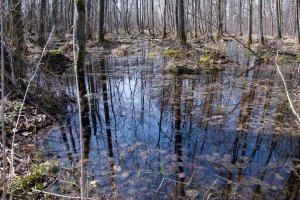World Wetlands Day: Celebrating and Saving Unique Habitats
February 2, 2023
By: Erin Parker, Interpretive Services Supervisor
World Wetlands Day is an annual celebration of one of our critically important and deeply misunderstood landscapes: wetlands! Here in Southeast Michigan, wetlands have been under-appreciated and over-developed for centuries. According to Michigan’s Department of Energy, Great Lakes and the Environment, coastal wetlands along the Great Lakes have decreased by half and those along the Detroit River by ninety percent. Inland wetlands aren’t faring much better, with Michigan’s long history of agriculture and waterfront industry, wetlands often face a losing battle against human development.
What’s a wetland?
Wetlands in Michigan include both permanently and seasonally saturated places. Wetlands come in a variety of forms from the cattail marshes in Lake Erie and Lake St Clair Metroparks to the vernal ponds in the hardwood forests at Stony Creek Metropark. Seasonally flooded areas hold pools of melting snow or capture spring rains and dry up most summers. The soils and plants that are supported by these annually flooded areas are different that higher parts of the forests where water doesn’t collect in the spring. Michigan’s amphibians are dependent on these areas for breeding and egg laying. Because they dry up seasonally, these shallow forest ponds don’t have fish populations and fish are a major predator of amphibian eggs and larvae.

Benefits of wetlands
Occupying the interface between land and water means that wetlands are typically nutrient-rich. This happens because land-based fertilizers, sediments, and even soils are dissolved in or carried by rain and storm water as they fall and move across land, pulled into wetlands by gravity. This, in turn, makes wetlands into critical habitat for a diverse list of species. According to the Environmental Protection Agency, wetlands make up approximately 5% of our land area in the continental US but more than 1/3 of our threatened and endangered species live in a wetland habitat. Fish, amphibians, and reptiles use wetlands for spawning or laying eggs in the spring; migrating birds use wetlands as stopover habitat that provides food and shelter; and even twenty-five percent of Michigan’s mammal species utilize wetlands for water, shelter, and/or food.

Wetlands also protect the shorelines along our lakes and rivers. Plants that thrive here tolerate fluctuating water levels and help hold streambanks in place, reduce erosion and flooding, and slow the flow of moving water. This helps maintain water quality by preventing the movement of sediments. Great Lakes water levels shift for a variety of reasons, often exacerbated by our changing climate. Warmer winters with less ice cover cause more evaporation off the lakes which can mean longer periods of intense snow (or rain, depending on the air temperature) each winter. Wetlands act like a sponge to absorb and buffer some of these increases in precipitation while also helping to protect shorelines from waves and wind.
Why are wetlands at risk?
Wetlands are found in many places that people also find appealing such as along beaches and other waterfronts. Before the many values of these areas were fully understood, they were cleared, drained, and filled to allow crops to be planted, homes to be built, and cities to spring up along shorelines and other waterfront.
World Wetlands Day has been celebrated since 1997 to promote, protect, and celebrate wetlands around the world. The date, February 2, is the anniversary of the signing of the Convention of Wetlands of Importance that took place in Ramsar, Iran, in 1971. Each year has a different theme, in 2023 the theme is “It’s time for Wetland Restoration”. Wetland restoration projects can enhance and protect water quality. Projects, such as shoreline softening, which replaces hardscapes with plants, coconut coir, and more natural materials can help buffer shorelines against dramatic changes in water levels, waves and currents, and stormwater.
Restored wetlands, like those at Lake St Clair Metropark, can help absorb and retain stormwater and become thriving ecosystems at the interface of land and water. Projects throughout our Metroparks work to balance the needs of park users with that of wildlife, and restored marsh and softened shorelines can help maintain clean water for all users.
Resources
Learn more about World Wetlands Day here: worldwetlandsday.org
